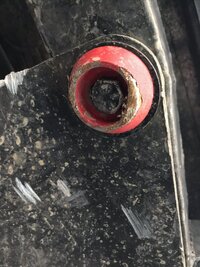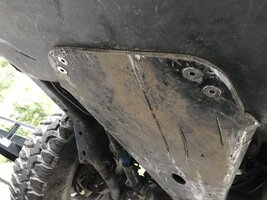I would give the button heads a try if you can find them. I have normal hex heads on mine and they definitely take a beating on the rocks. Perhaps button heads would slide a bit easier? Flat heads are the way to go but don't work easily when your skid holes are slotted.Should I use regular hex head bolts or Button head bolts?
You are using an out of date browser. It may not display this or other websites correctly.
You should upgrade or use an alternative browser.
You should upgrade or use an alternative browser.
Aluminum vs steel skid plates?
- Thread starter Gollywomper
- Start date
You can get these but they are larger than they seem.
https://www.barnes4wd.com/12-to-916-Bolt-Head-Protector_p_1306.html
https://www.barnes4wd.com/12-to-916-Bolt-Head-Protector_p_1306.html
It's been done....Flat heads are the way to go but don't work easily when your skid holes are slotted.
Do those just get clamped in place by the bolt head or are they better off with a couple small welds on them?You can get these but they are larger than they seem.
https://www.barnes4wd.com/12-to-916-Bolt-Head-Protector_p_1306.html
Might look ok tig welded if you have a steel skid.Do those just get clamped in place by the bolt head or are they better off with a couple small welds on them?
That looks great! Not as easy to do on a slot though. I'm assuming you went to town with a die grinder or something similar? Or was the aluminum forgiving enough to get away with a traditional countersink cutter? Nice work either way!It's been done.
View attachment 302221
One side is slotted. I forget which. I bought a piloted counter sink bit and extended the pilot to fit into the threads in the frame. Then once the counter sink was well established, I made it deep enough for the bolt head with a router bit chucked into a drill.That looks great! Not as easy to do on a slot though. I'm assuming you went to town with a die grinder or something similar? Or was the aluminum forgiving enough to get away with a traditional countersink cutter? Nice work either way!
Another option is to make a pair of drilled and countersunk rails out of 6061 the length of the skid. That entirely gets rid of the bolt heads and makes a smooth sliding surface.You can get these but they are larger than they seem.
https://www.barnes4wd.com/12-to-916-Bolt-Head-Protector_p_1306.html
Last edited:
I am thinking I will use a button head bolt. If they get damaged I will reassess getting them out of harms way.
Do those just get clamped in place by the bolt head or are they better off with a couple small welds on them?
They just get clamped in place by the bolt. I'll find the ones I ordered and post a picture.
I did the grade 8 hex bolts with Barnes bolt head protectors on the frame, and countersunk the engine skid holes and added stainless like @DrDmoney recommended.For the frame attachment? I would use grade 5 or better hex head cap screws with a stainless washer. For engine skid to TC skid, countersunk flat head stainless.


I really like the countersunk rail idea @jjvw mentioned too.
We aren't trying to protect the bolt heads, we are trying to not have something there to get hung up on. You went the wrong way. That and we never use stainless underneath with an Allen drive unless it is through bolted. The driver size is too small, stainless smears way to easily, and they are miserable to remove. At least use Phillips drive.I did the grade 8 hex bolts with Barnes bolt head protectors on the frame, and countersunk the engine skid holes and added stainless like @DrDmoney recommended.View attachment 302246View attachment 302248
I really like the countersunk rail idea @jjvw mentioned too.
I agree, my frame mount bolts and protectors do get hung up and more than I would like, so I need a better solution. What are your thoughts on the countersunk rail mentioned earlier? I’d like to do that to the existing skid plate holes, but they are slotted and unable to be countersunk effectively.We aren't trying to protect the bolt heads, we are trying to not have something there to get hung up on. You went the wrong way. That and we never use stainless underneath with an Allen drive unless it is through bolted. The driver size is too small, stainless smears way to easily, and they are miserable to remove. At least use Phillips drive.
The 4 engine skid bolts are through bolted as well. I sheared off the steel button head bolts that were originally used which is why I went with the countersunk bolts.
For the Savvy and any other skids that don't support the transmission I could see countersinking, for the others the countersunk glide rail would be a better option.Another option is to make a pair of drilled and countersunk rails out of 6061 the length of the skid. That entirely gets rid of the bolt heads and makes a smooth sliding surface.
Last edited:
I ordered some grade 8 button heads for the initial install. But I will be going the guide rail route. I’m guessing T6 would be the proper route. Anything special about counter sinking T6? If I can find it?For the Savvy and any other skids that don't support the transmission I could see countersinking for the others the countersunk glide rail would be a better option.
You tell stories.I ordered some grade 8 button heads for the initial install.
Or I m
that’s what they claim they are? That’s all I know. LolYou tell stories.
A button head requires a counter bored hole vs a flat head which uses a counter sunk hole, the underside of the button head needs to be on a flat surface, the counter sink makes an angled hole. the only problem will be sourcing the proper size counter bore bit.I ordered some grade 8 button heads for the initial install. But I will be going the guide rail route. I’m guessing T6 would be the proper route. Anything special about counter sinking T6? If I can find it?
I would have said titaniumOr I m
that’s what they claim they are? That’s all I know. Lol
